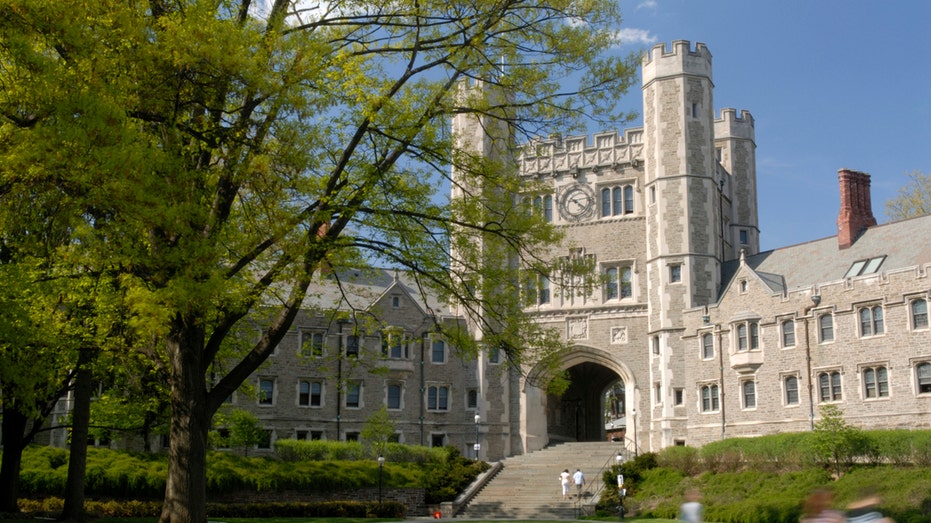After record year, university-endowment returns drop into negative territory
Endowments post their worst losses since 2009 as stocks, bonds, other assets decline
Kennedy hits the streets to ask: Is college worth it?
Fox Business host Kennedy and panelists Karol Markowicz, Kevin Walling and Hannah Cox discuss President Biden's student loan handout and whether or not college is worth the price.
Investment returns for university endowments have fallen back to earth after scoring their biggest gains in a generation the year before, reflecting a dramatically changed investment environment in which stocks, bonds and other assets have sold off sharply.
The endowment of Washington University in St. Louis lost 10.6% in the fiscal year ended June 30 after notching a 65% gain the prior year, the school told The Wall Street Journal, shrinking its size to $13.3 billion. Other schools that have reported big swings in their multibillion-dollar endowments include Stanford University, which lost 4.2% after gaining 40.1% previously; Brown University, down 4.6% after posting a 51.5% increase; and the Massachusetts Institute of Technology, down 5.3% after rising 55.5%.
The median result for endowments and foundations in the fiscal year ended June 30 was a 7.8% loss, according to a preliminary estimate by Cambridge Associates—the worst showing since 2009. Some endowment chiefs and advisers said the returns likely would have been even worse if venture-capital and private-equity valuations fully reflected the deep declines in public markets, a potential overhang on future performance.

In this Aug. 13, 2019 file photo, students walk near the Widener Library at Harvard University in Cambridge, Mass. (AP Photo/Charles Krupa, File)
HARVARD'S ENDOWMENT HAS FIRST YEAR OF NEGATIVE RETURNS SINCE 2016
Surging venture-capital returns boosted large endowments’ returns the prior year, ushering in a raft of expanded financial-aid initiatives and other programs despite the fact that some of the gains were unrealized.
Endowments also help fund faculty salaries and capital projects. "If this continues for another year there will be impacts," said Margaret Chen, global head of Cambridge’s endowments and foundations practice.
Still, she said endowments were cushioned from steeper losses by diversification in their portfolios, which beyond public and private equity and fixed income often include hedge funds, real estate, private credit and cash. A benchmark portfolio made up of 70% global stocks and 30% Bloomberg Aggregate bond index lost 13.8% for the period, according to Cambridge.

New Haven, USA - May 4, 2015: Yale University campus on April 4, 2015. It is a private Ivy League research university in New Haven, Connecticut. Founded in 1701 (iStock / iStock)
Many schools’ use of a "smoothing formula" to determine the size of their endowment’s distribution to their budget has limited fallout from the losses, said Greg Dowling, investment chief of Cincinnati, Ohio-based investment consultant Fund Evaluation Group. Such formulas typically take into account several factors, including an endowment’s average market value over three years or more, in an effort to dampen the effect of wild performance swings.
Public- and private-equities markets have retreated as central banks around the world raise interest rates in the face of surging inflation. The S&P 500, the Nasdaq Composite and the MSCI ACWI index lost 10.6%, 23.4% and 15.4% respectively, including dividends, for the year ended June 30, their biggest losses in more than a decade, according to Dow Jones Market Data.
Oil and gas, a rare bright spot in markets that soared after Russia invaded Ukraine, did little to aid endowment returns. Numerous endowments have adopted divestment policies in recent years amid efforts to combat climate change, limiting their exposure.

Princeton University
One exception was Princeton University, whose endowment benefited from its exposure to fossil-fuel companies, said people familiar with the matter. Princeton in September said it would divest from public fossil-fuel and from thermal-coal and tar-sands companies. The university didn’t address its other private oil- and gas-related holdings. The endowment lost 1.5% in the fiscal year ended in June after a 46.9% gain the prior year, and stood at $35.8 billion as of June 30.
Endowments’ investments in venture capital have proved particularly thorny.
Private companies have postponed initial public offerings and laid off employees. Some, including Instacart Inc. and Klarna Bank AB, have slashed their valuations.
But valuations overall have remained relatively high as managers wait for events like new funding rounds or public offerings to revalue their private investments.
"Venture is like a mile-long train and there’s been an accident at the very front of the train. It’s going to take awhile to work through," said Matt Bank, a partner at Charlotte, N.C.-based Global Endowment Management, an outsourced investment office that manages $12 billion for clients, including endowments.
Harvard endowment chief N.P. "Narv" Narvekar suggested venture managers hadn’t written down their private investments sufficiently, saying in his annual letter this month that the funds’ performance largely reflected their exposure to public markets. The absence of write-downs "does make us cautious about forward-looking returns in private portfolios," he wrote.
Harvard’s endowment, which is less heavily invested in venture capital than some of its peers, lost 1.8% the fiscal year ended in June after notching a 33.6% gain a year earlier. The endowment stood at $50.9 billion as of June 30.
Differences in how schools report the performance of their private investments are making it unusually difficult to compare returns, endowment chiefs and advisers said. While some included lagged returns for the year through March 31—generally benefiting from early gains and a public-markets selloff that was in earlier innings—others included private returns for the year through June 30.
Many endowment chiefs’ letters were thin on details about how they were navigating the changed investment environment. One of the most illuminating accounts came early this year, in a March letter by MIT Investment Co. President Seth Alexander, who wrote the endowment’s exposure to "profit tomorrow" companies had been of rising concern in recent years. MIT’s endowment had soared to $27.4 billion as of June 30, 2021, from $18.4 billion a year earlier.

Students walk past the "Great Dome" atop Building 10 on the Massachusetts Institute of Technology campus, April 3, 2017, in Cambridge, Mass. ( AP Photo/Charles Krupa, File / AP Newsroom)
To manage through the volatility created by valuation swings and to avoid a fire sale of assets to fund short-term needs, he wrote, the endowment was holding cash, making smaller commitments to illiquid funds and keeping a "small portfolio" of hedges.
CLICK HERE TO GET THE FOX BUSINESS APP
"We suspect that this balancing act between investing capital into new areas of innovation and having the appropriately defensive posture to tolerate a downturn will be one of our main challenges in the years to come," Mr. Alexander wrote.




















